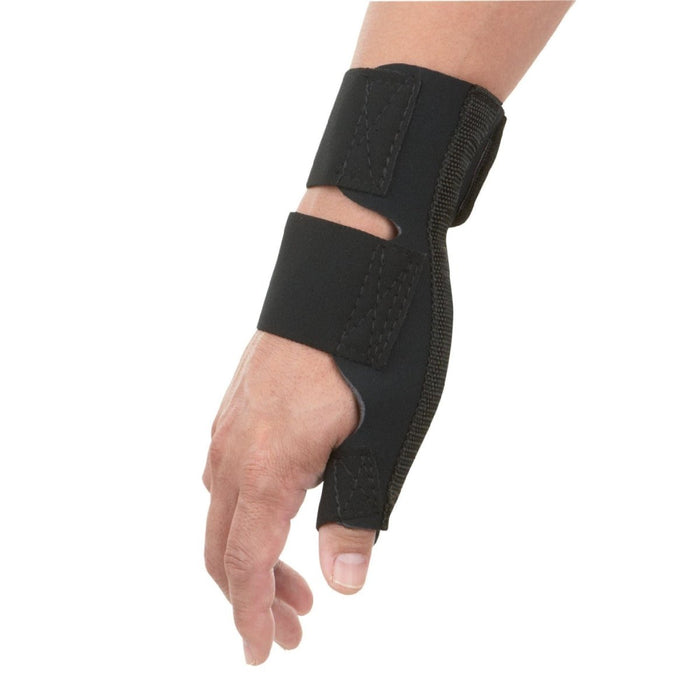De Quervain’s Tenosynovitis is a painful condition affecting the tendons on the thumb side of the wrist. It occurs when the sheaths surrounding these tendons become inflamed, making thumb and wrist movements painful and difficult. This condition is commonly seen in individuals who perform repetitive hand motions, such as lifting, typing, or gaming.
Often referred to by various names, including "Mommy Thumb," "Texting Thumb," and "Gamer’s Thumb," De Quervain’s Tenosynovitis is a common overuse injury that can impact anyone engaged in frequent gripping or wrist movements.
Understanding the causes, symptoms, and treatment options can help manage this condition effectively and prevent further discomfort.
Causes & Symptoms of De Quervain's Tenosynovitis
Causes of De Quervain's Tenosynovitis
-
Repetitive Hand & Wrist Movements: Activities like typing, texting, gaming, or lifting children can strain the tendons.
-
Inflammation from Overuse: Repetitive gripping and wrist motions can cause swelling in the tendon sheath.
-
Pregnancy & Postpartum Changes: Hormonal shifts and fluid retention may increase tendon sensitivity.
-
Arthritis & Autoimmune Conditions: Rheumatoid arthritis and other inflammatory disorders can contribute to tendon irritation.
-
Direct Injury to the Wrist: Trauma or impact to the area may lead to swelling and reduced tendon mobility.
Symptoms of De Quervain's Tenosynovitis
-
Pain & Swelling: Discomfort at the base of the thumb and along the wrist, especially during movement.
-
Difficulty Gripping: Weakness or pain when grasping objects or making a fist.
-
Stiffness & Limited Mobility: Reduced range of motion in the thumb and wrist.
-
Popping or Snapping Sensation: A catching or snapping feeling when moving the thumb.
-
Increased Pain with Activity: Actions like pinching, writing, or holding a phone can worsen symptoms.
Pro Tip: If left untreated, De Quervain’s Tenosynovitis can worsen over time, making simple movements increasingly painful. Early intervention is key to a faster recovery.
Diagnosing De Quervain's Tenosynovitis
Diagnosing De Quervain’s Tenosynovitis involves a physical examination to assess pain levels, swelling, and thumb movement. A healthcare provider will typically perform a simple test to confirm the condition.
-
Finkelstein’s Test: This is the primary diagnostic test. The patient makes a fist with their thumb tucked inside their fingers, then bends the wrist towards the pinky side. Sharp pain in the wrist or thumb area indicates De Quervain’s Tenosynovitis.
-
Palpation & Tenderness Check: The doctor will gently press on the tendons near the base of the thumb to check for swelling and pain.
-
Range of Motion Assessment: Evaluating thumb and wrist movement helps determine the severity of inflammation.
-
Imaging Tests (Rarely Needed): In severe or unclear cases, an X-ray or ultrasound may be used to rule out fractures, arthritis, or other conditions.
Early diagnosis allows for more effective treatment, helping to prevent further complications and long-term discomfort.
Treatment Options for De Quervain's Tenosynovitis
Treatment for De Quervain’s Tenosynovitis focuses on reducing inflammation, relieving pain, and restoring hand function. Most cases improve with non-surgical treatments, but severe cases may require medical intervention.
Rest & Activity Modification
Avoid repetitive thumb and wrist movements to allow healing.
Medication & Therapy
NSAIDs help reduce swelling, while physical therapy improves strength and mobility.
Medical Procedures
Corticosteroid injections reduce inflammation; surgery is a last resort for severe cases.
Best Braces for De Quervain's Tenosynovitis
Wearing a brace can help stabilize the thumb and wrist, reducing strain on the inflamed tendons and promoting healing. Below are expert-recommended braces designed for optimal support and comfort.

Brace Direct Mini Thumb Spica Splint
Compact & Lightweight Support
This splint provides targeted stabilization for the thumb while allowing some finger mobility. Its adjustable straps ensure a comfortable fit for all-day wear.
Shop Now

Brace Direct Wrist Splint with Thumb Spica
Full Wrist & Thumb Stabilization
Designed for comprehensive support, this wrist brace immobilizes both the thumb and wrist, reducing movement that can aggravate symptoms.
Shop Now

Breg Adjustable Universal Thumb Spica Brace
Advanced Comfort & Support
Made with a soft, breathable material, this brace offers superior comfort while effectively immobilizing the thumb for recovery.
Shop Now
Living with De Quervain's Tenosynovitis
Managing De Quervain’s Tenosynovitis requires a combination of treatment, lifestyle modifications, and preventive measures. With the right approach, most people can return to daily activities without persistent pain or discomfort.
-
Modify Hand Movements: Avoid repetitive thumb and wrist motions that could worsen symptoms.
-
Use a Brace: Wearing a thumb spica splint during activities can help stabilize the wrist and prevent flare-ups.
-
Practice Gentle Exercises: Physical therapy exercises can improve flexibility and strengthen supporting muscles.
-
Alternate Between Hot & Cold Therapy: Ice reduces inflammation, while heat helps relax muscles and improve circulation.
-
Take Breaks from Straining Activities: Give your hands time to rest, especially during activities that involve frequent gripping.
-
Maintain Good Ergonomics: Adjust your workstation, grip, or technique to reduce strain on your wrist and thumb.
-
Address Underlying Conditions: If arthritis or other inflammatory conditions are contributing factors, managing them can help prevent future issues.
With proper care and support, most cases of De Quervain’s Tenosynovitis improve over time. If symptoms persist despite treatment, consult a healthcare provider for further evaluation.
Find the Right Support for De Quervain's Tenosynovitis
Choosing the right brace or splint can make a significant difference in your recovery and daily comfort. Explore our selection of thumb and wrist supports designed specifically for De Quervain’s Tenosynovitis.
Need help selecting the right support? Our bracing experts are available to guide you toward the best solution for your needs.




